"Dunkirk"
Production Notes |
Read more at in70mm.com The 70mm Newsletter |
| Written by: Warner Brothers. Images by: - | Date: 10.07.2017 |
 Mats
Kullander, and the 70mm print for Rigoletto, Stockholm, Sweden Mats
Kullander, and the 70mm print for Rigoletto, Stockholm, SwedenFrom filmmaker Christopher Nolan (“Interstellar,” “Inception,” “The Dark Knight” Trilogy) comes the epic action thriller “Dunkirk.” “Dunkirk” opens as hundreds of thousands of British and Allied troops are surrounded by enemy forces. Trapped on the beach with their backs to the sea, they face an impossible situation as the enemy closes in. The story unfolds on land, sea and air. RAF Spitfires engage the enemy in the skies above the Channel, trying to protect the defenseless men below. Meanwhile, hundreds of small boats manned by both military and civilians are mounting a desperate rescue effort, risking their lives in a race against time to save even a fraction of their army. “Dunkirk” features a multigenerational ensemble cast, including Fionn Whitehead, Tom Glynn-Carney, Jack Lowden, Harry Styles, Aneurin Barnard, James D’Arcy and Barry Keoghan, with Kenneth Branagh, Cillian Murphy, Mark Rylance and Tom Hardy. Nolan directed “Dunkirk” from his own screenplay, utilizing a mixture of IMAX® and 65mm film to bring the story to the screen. The film was produced by Emma Thomas and Nolan, with Jake Myers serving as executive producer. The behind-the-scenes creative team on “Dunkirk” included director of photography Hoyte van Hoytema, production designer Nathan Crowley, editor Lee Smith, costume designer Jeffrey Kurland, visual effects supervisor Andrew Jackson and special effects supervisor Scott Fisher. The music was composed by Hans Zimmer. Warner Bros. Pictures presents a Syncopy Production, a film by Christopher Nolan, “Dunkirk.” Opening in conventional theatres and IMAX, the film will be distributed by Warner Bros. Pictures, a Warner Bros. Entertainment Company. Dunkirkmovie.net |
More in 70mm reading: “Dunkirk”: A personal first impression "Dunkirk" in the splendour of 7OMM Christopher Nolan to Direct the Epic Action Thriller “Dunkirk” in 65mm for Warner Bros. Pictures Nolan's "Dunkirk" will feature over 100 minutes of IMAX material Acclaimed filmmaker Christopher Nolan directs an international cast in “Interstellar” in70mm.com's IMAX Page Chronological premiere list of all real 70mm films Now showing in 70mm in a theatre near you! Internet link: • Variety • Deadline • indiewire.com • dunkirkmovie.com • slashfilm.com • slate.com French release: • July 17th 20:30, in the presence of Christopher Nolan "Grand Rex" • Paris "Gaumont Marignan" • "Grand Mercure Elbeuf" • "Kinepolis - Lomme" • cloneweb.net |
ABOUT THE PRODUCTION |
|
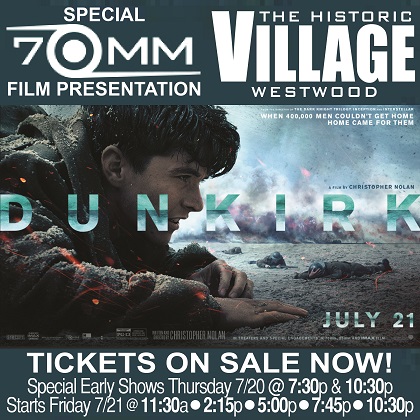 Christopher Nolan has taken audiences from the
streets of Gotham City, to the infinite world of dreams, to the farthest
reaches of space. Now, for the first time, the innovative
director/writer/producer has turned his camera to a real-life event, one
that has resonated with him throughout his life: the miracle of Dunkirk. Christopher Nolan has taken audiences from the
streets of Gotham City, to the infinite world of dreams, to the farthest
reaches of space. Now, for the first time, the innovative
director/writer/producer has turned his camera to a real-life event, one
that has resonated with him throughout his life: the miracle of Dunkirk.“Dunkirk” is based on the evacuation that—although it took place in the early months of World War II—had a direct impact on the outcome of the war. Rather than make a battlefield drama, however, Nolan’s objective was to turn this historical moment into immediate, immersive cinema: a propulsive, ticking-clock, epic action thriller in which the stakes couldn’t be higher. He affirms, “What happened at Dunkirk is one of the greatest stories in human history, the ultimate life-or-death race against time. It was an extraordinarily suspenseful situation; that’s the reality. Our aim with this movie was to throw the audience into that with an absolute respect for history, but also with a degree of intensity and, of course, a sense of entertainment, too.” Nolan’s longtime producing partner, Emma Thomas, offers, “‘Dunkirk’ is a huge spectacle film, but also a very human story and, in that way, it’s universal. Chris wanted to put the audience in the center of the experience along with the characters, whether they be the soldiers on the beach, the pilots in the air, or the civilians on the boats.” The remarkable true story that inspired the fictional film is one that has fascinated Nolan for many years “and one I’ve been wanting to tell for quite some time,” he says. “Like most British people, I was raised on the mythical story of the evacuation of Dunkirk, and the victory that was snatched from the jaws of defeat,” he relates. “It’s a massive part of our culture. It’s in our bones.” The story began in late May 1940, when the British Expeditionary Force, along with French, Belgian and Canadian troops were forced back to the beaches of Dunkirk. Though home was just 26 miles away, there was no easy way to reach it. The shallow-drafted beach, with its 21-foot tide, prohibited the large British naval ships from rescuing the men. But there was hope: a call had gone out for small boats to aid the effort and a flotilla of non-military “little ships” sailed out from the southern coast of England to bring the men home, codenamed Operation Dynamo. |
|
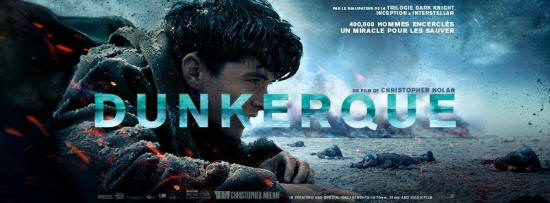 The film’s historical consultant, Joshua Levine, author of the book
Forgotten Voices of Dunkirk, emphasizes that the 1940 evacuation is far more
than just a British story. “It was a massive event that still has
international significance. Everything that’s celebrated about World War
II—in Britain, in the United States, and all around the world—would not have
happened without the Dunkirk evacuation taking place. It was unbelievably
important. If the British army had been killed or taken prisoner, Britain
would almost certainly have surrendered, and we’d likely be living in a very
different world today. To me, Dunkirk is about the preservation of freedom.
Once those ships were underway, the world still had a chance.” The film’s historical consultant, Joshua Levine, author of the book
Forgotten Voices of Dunkirk, emphasizes that the 1940 evacuation is far more
than just a British story. “It was a massive event that still has
international significance. Everything that’s celebrated about World War
II—in Britain, in the United States, and all around the world—would not have
happened without the Dunkirk evacuation taking place. It was unbelievably
important. If the British army had been killed or taken prisoner, Britain
would almost certainly have surrendered, and we’d likely be living in a very
different world today. To me, Dunkirk is about the preservation of freedom.
Once those ships were underway, the world still had a chance.” Kenneth Branagh, who plays the British naval commander, agrees. “Your life and mine would have been profoundly changed had that courageous, brave, patient, impossible moment not been lived through by people who stuck at it, and in so doing protected all of our futures. Its place in our military, social, political, and emotional history can never be underestimated. In a sense, you could look at an evacuation as being unheroic, but somehow it adds up to something phenomenally heroic about the human spirit.” In fact, the rescue of their stranded army against seemingly impossible odds gave rise to a term that is a permanent part of the British cultural lexicon: “the Dunkirk spirit.” Thomas defines, “It’s something English people pride themselves on: that sort of plucky grit and determination in the face of adversity.” Mark Rylance, who plays the captain of one of the little ships, concurs, “It has a deep meaning for the English people. We were the underdogs on that beach, but we rose to the occasion and eluded the superior forces of the enemy at that time. The Dunkirk spirit has to do with that perseverance and endurance and also selflessness.” Newcomer Fionn Whitehead, who takes on the role of one of the young British soldiers on the beach, says, “The Dunkirk spirit brings to my mind a sense of togetherness and a show of community—coming together to help out someone in trouble.” |
|
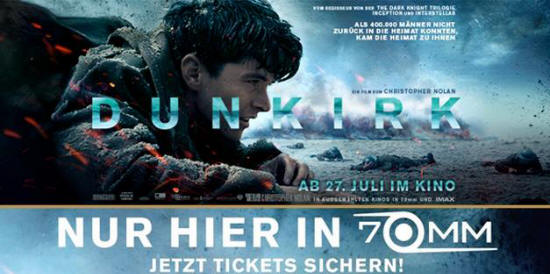 It was with a friend on his small sailing boat—similar to those that formed
the “little ships”—that Nolan and Thomas first visited Dunkirk during the
mid-1990s. The trip would give them a whole new appreciation for the seminal
event they had only read about. Hampered by rough seas and bad weather, the
voyage across the Channel unexpectedly took 19 hours. “It was a very arduous
crossing,” Nolan recalls, “and that was with nobody dropping bombs on us.
What really stuck with me was just how extraordinary it was, the notion of
civilians taking small boats into a war zone. They could see the smoke and
the fires for many miles, so their willingness to do that and what that says
about communal spirit are extraordinary.” It was with a friend on his small sailing boat—similar to those that formed
the “little ships”—that Nolan and Thomas first visited Dunkirk during the
mid-1990s. The trip would give them a whole new appreciation for the seminal
event they had only read about. Hampered by rough seas and bad weather, the
voyage across the Channel unexpectedly took 19 hours. “It was a very arduous
crossing,” Nolan recalls, “and that was with nobody dropping bombs on us.
What really stuck with me was just how extraordinary it was, the notion of
civilians taking small boats into a war zone. They could see the smoke and
the fires for many miles, so their willingness to do that and what that says
about communal spirit are extraordinary.”Nolan continues, “In looking at how to tell the story, I came fairly early on to the idea of showing events from the land, sea and air: seeing the action from the perspectives of the men on the beach, the people coming to help on the boats, and the pilots trying to protect them from above. I was immediately struck by the need to use a different time scale for each strand of the story because the guys on the beach are there for the better part of a week in the film, while the boat crossing takes place over the course of a long day, and the action in the Spitfires involves a single hour. Each of those storylines—one week on land, one day at sea and one hour in the air—had different temporal characteristics, so in braiding them together editorially, I had to plot them out very carefully. Intertwining these stories leads you through the events in a very subjective way and allows you to understand the journey each of the characters is on, while always trying to suggest that there are many other unseen journeys. In an event of this magnitude, you can’t possibly get a comprehensive understanding of so many individual experiences in a single film.” Researching the script, Nolan read several books and firsthand accounts. He also consulted extensively with Levine, whom he says, “very quickly understood the tricky balance between entertainment and historical accuracy that we were trying to strike. He also arranged for us to meet with some surviving veterans of Operation Dynamo. It was a great, great honor to meet those people and hear about their experiences and discover what Dunkirk meant to them.” “Nevertheless,” Thomas notes, “Chris felt strongly that he didn’t want to put words in the mouths of these real-life heroes, or have to change their stories for reasons of time or dramatic effect, and decided that the best way to approach the story was to use fictional characters inspired by those elements he discovered in doing his research.” |
|
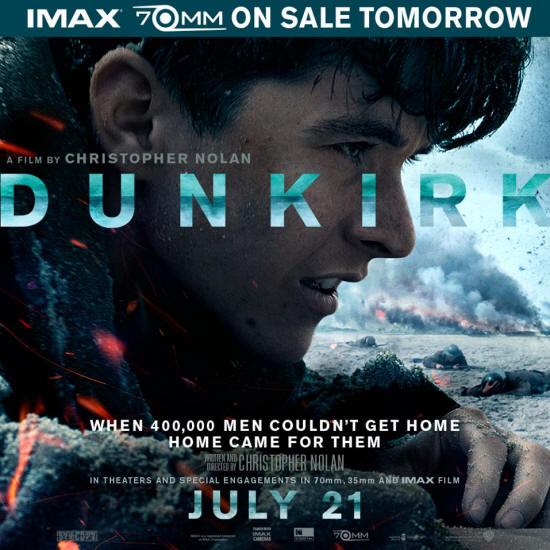 Seeing the event through the eyes of just a few individual characters was
something that struck Branagh when he read the script. “Chris managed to
weave together a very human story that brings all those personal moments
together within this epic dimension,” the actor states. “He is quite
brilliant in my view, a master filmmaker.” Seeing the event through the eyes of just a few individual characters was
something that struck Branagh when he read the script. “Chris managed to
weave together a very human story that brings all those personal moments
together within this epic dimension,” the actor states. “He is quite
brilliant in my view, a master filmmaker.”Rylance adds, “I don’t imagine anyone else could have done a more faithful and essential telling of this story in a more thrilling and exciting way. I think it makes for an extraordinary movie-going experience.” Cast in his third Christopher Nolan film, Tom Hardy agrees. “Time and time again, Chris consistently manages to raise the bar. He is a true professional who doesn’t leave a stone unturned or dismiss an opportunity. He’s always in control and set in his volition, but he is not inflexible. That’s extremely powerful for an artist. He’s generous, sensitive, funny and incredibly intelligent, and I trust him—if he says he’s going to do something, he will.” To help him achieve his time-bending, threefold vision for the film, Nolan collaborated with his creative team, including director of photography Hoyte van Hoytema, production designer Nathan Crowley, costume designer Jeffrey Kurland, editor Lee Smith, special effects supervisor Scott Fisher and visual effects supervisor Andrew Jackson. Nolan’s primary goal was to put the audience directly onto the beach, onboard the boat traversing the Channel, and in the cockpit of the Spitfires. He had been the first to use IMAX cameras in a major motion picture, for “The Dark Knight,” and has employed IMAX cameras on all of his subsequent films. But for “Dunkirk,” he expanded the use of large format—shooting the entire film with a combination of IMAX and 65mm film, something, he confirms, “I’ve never done before, but ‘Dunkirk’ is a huge story and it demanded an enormous canvas. “The reason we were shooting on IMAX film,” the director continues, “is that the immersive quality of the image is second to none. When you sit in the movie theatre, the screen disappears and you really get a very tactile sense of the imagery. That lends itself to incredible panoramas and large-scale action. But we’ve also found over the years that if you use it for more intimate situations, it creates an immediacy that’s very engaging. So our feeling was, if we could find a way to do it physically, the payoff would be well worth it.” Another hallmark of Nolan’s films is his preference for capturing the action in-camera and eschewing digital effects and CGI as much as possible. “To me,” he clarifies, “it’s always very important to try and work with real things and real people. The resulting effect of that is very visceral and enveloping, and draws you into the story.” That was equally true for the cast. Cillian Murphy, working with the director for the fifth time, asserts, “I can only speak for myself, but I do think the rest of the actors would attest to this as well: when you’re in the environment and things are happening for real, it leads to a more honest, truthful portrayal of your character’s journey.” Adding to the verisimilitude, the filmmakers, cast and crew were honored to have the opportunity to film a portion of “Dunkirk” on the actual beach and at the exact same time of year that the miraculous evacuation happened. There were some logistical challenges, including inclement weather, rough seas, and the construction of the mole: a narrow, kilometer-long, wood-boarded breakwater that poked precariously out into the cold waters of the Channel. Nevertheless, Thomas says it was the best possible choice. “The beach at Dunkirk is a singular place,” she states. “We looked at other options, but it became clear that it would be difficult to replicate exactly the look we needed anywhere else. We all felt very lucky to be able to shoot at the location where the event occurred.” |
|
RECRUITING THE CAST |
|
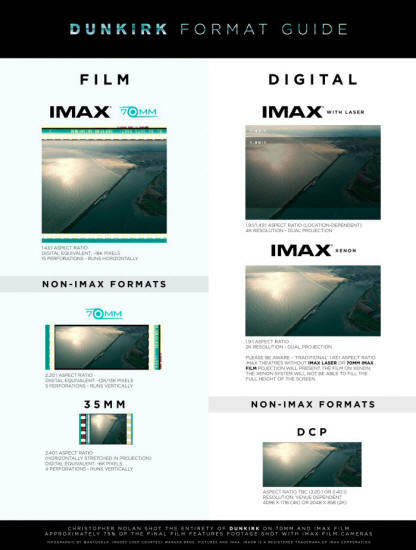 Christopher Nolan’s quest for authenticity
extended to his choice of actors, especially with regard to the young men
whose lives are on the line. The director expounds, “In each of the three
story strands, I wanted to cast actors who were close to the ages of the
characters. We were determined to be true to the reality of how young these
men would have been when they went off to fight in this terrible conflict.
Some of them were just kids. We wanted fresh faces so the audience can
experience these events through their eyes.” Christopher Nolan’s quest for authenticity
extended to his choice of actors, especially with regard to the young men
whose lives are on the line. The director expounds, “In each of the three
story strands, I wanted to cast actors who were close to the ages of the
characters. We were determined to be true to the reality of how young these
men would have been when they went off to fight in this terrible conflict.
Some of them were just kids. We wanted fresh faces so the audience can
experience these events through their eyes.” One of their discoveries was Fionn Whitehead, who makes his big-screen debut in the key role of Tommy. Coming under fire, the young soldier barely escapes from the neighboring town only to find himself stranded with hundreds of thousands of other soldiers on the Dunkirk beach, awaiting their fate. Describing his character, Whitehead says, “Tommy is kind of your classic Average Joe soldier. He’s just very young and inexperienced, and probably didn’t know what he was signing up for. But he’s resourceful and determined to do whatever he can to survive.” Shortly after arriving on the beach, Tommy encounters Gibson, a fellow soldier with whom he connects. Aneurin Barnard, who plays Gibson, explains, “The only way they’re gonna get off that beach is by bearing a stretcher together and trying to get onto the hospital ship at the end of the mole. So we adopt a very quick relationship and this trust has to happen straight away. Both of us hold each other’s lives in our hands.” The plan does get them onto the mole where they meet Alex, portrayed by Harry Styles in his feature film debut. “Alex is a young soldier who seems nice, but there’s also this edge to him,” Styles says. “He comes off a little more hardened than the other guys. Alex likes the idea of being the tough guy, but he’s also really scared.” For Styles, it came as no surprise that Tommy, Gibson and Alex would quickly find a common bond. “I think for the guys in uniform, it didn’t matter what job the guy next to you did. It was you and him; it was, ‘All right, we’re on the same side, so we’re sticking together. We’re gonna help each other out of this.’ It’s just pure camaraderie. They might not even know each other’s name, but it doesn’t really matter. He’s in the same uniform as you, so you’re on the same team. It’s like family.” Tommy, Gibson and Alex’s narrow gateway to freedom is the mole, a perilous eight-foot-wide pier overseen by the naval officer in charge, Commander Bolton, played by Kenneth Branagh. “Bolton is the man responsible for organizing the logistics of boats and ships coming to the mole, where boats can moor, collect their soldier passengers and then move off,” he says. “And there is a necessity for that to happen swiftly, with maximum efficiency, because they’re being fired at. So it’s a position of immense responsibility in a key area, and Bolton has to be calm under pressure while making life-or-death decisions. It just simply wasn’t possible to get everyone off because the numbers were so huge. It’s an appalling situation to be placed in.” The ranking army officer on the mole with Bolton is Colonel Winnant. James D’Arcy, who plays the role, says, “Winnant spends much of his time discussing with Commander Bolton the logistics of how we’re are going get the men out of there. Most of the story is told through the eyes of these kids, who haven’t got a clue what’s going on, so Colonel Winnant and Commander Bolton are among the few characters who truly understand what is happening here.” The two senior officers are also among the very few men on the beach who are aware of Operation Dynamo: the mobilization of civilian boats that are able to get closer to shore and save even a fragment of their armed forces. |
|
 One of those boats coming over from England is the Moonstone, a small,
wooden yacht owned and piloted by Mr. Dawson. Mark Rylance relates, “What
drew me to the project was the history and also Chris’s interesting
treatment of the story in his script, which I thought was wonderful. One of those boats coming over from England is the Moonstone, a small,
wooden yacht owned and piloted by Mr. Dawson. Mark Rylance relates, “What
drew me to the project was the history and also Chris’s interesting
treatment of the story in his script, which I thought was wonderful.“My character is one of the many hundreds of English civilians who responded to a call to take their pleasure yachts or their little boats and sail across the Channel and get these men off the beach,” Rylance says. Joining Mr. Dawson on the mission is his 19-year-old son, Peter, played by Tom Glynn-Carney, who calls making his feature film debut on a Christopher Nolan film “being thrown in the deep end, but Chris was everything I’d hoped he’d be and more. He was so helpful and I trusted him with every ounce of my being. It was also nice being taken under the wing of someone like Mark. Just watching and learning from him was invaluable and worked for our relationship on camera as father and son.” As Mr. Dawson and Peter are about to embark, Peter’s friend George jumps on the Moonstone, determined to share in what he thinks will be an adventure…his first. Cast in the role, Barry Keoghan attests, “George just hops onboard not really understanding what he’s headed for. He looks up to Mr. Dawson and wants to help, but he is somewhat naïve about what’s happening on the other side of the Channel.” However, not everybody on the Moonstone is eager to get to Dunkirk. Midway in their voyage, Mr. Dawson and the boys pick up a shell-shocked survivor of a torpedoed ship. Cillian Murphy plays the man known only as the Shivering Soldier, who has no intention of returning to the hell he’d just barely escaped. “My character represents the profound effect that war can have on an individual’s mental state,” Murphy relates. Regardless of the fact that his character is never given a name, Murphy says he had no hesitation taking the role for the opportunity to work again with Nolan. “Chris’s films have this epic nature and scale, yet when you’re making them, you feel they’re very compact and truthful. You never feel lost amidst these huge productions because of the way he works. It’s the proximity he has to the actors—he’s always there going through everything with you. He’s completely hands-on in every way.” |
|
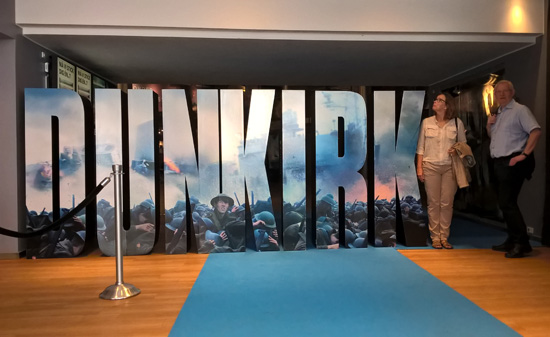 Poster
display Copenhagen. Image: Thomas Hauerslev Poster
display Copenhagen. Image: Thomas HauerslevHigh above the waters of the Channel and the sands of the beach, RAF Spitfires soar in to do battle with the Luftwaffe planes that are attacking the men and boats below. Jack Lowden, who portrays Collins, the youngest of the Spitfire pilots, says, “Our mission is to protect the soldiers on the beach. We’re in a sortie over Dunkirk, and pretty quickly it all starts kicking off. Those guys are up there doing a job. They weren’t drafted; being an RAF pilot was a choice and a very privileged choice. You had to be quick and smart. Collins has chosen to do this for himself as much as for king and country.” Tom Hardy, who plays Farrier, the more senior RAF pilot, had perhaps the most personal connection to the project. “My granddad was at Dunkirk,” he reveals. “He told me about it.” Emma Thomas says there were other reasons Hardy was perfect for the role. “He’s in a small cockpit of a plane, so his movements are very restricted, but Tom has a very big presence and can use his physicality in very interesting ways. And once again, we have much of his face covered, but the reason you can do that with Tom is because he is such an expressive actor you don’t need to see all of his face. There are moments in the film where all that’s visible are his eyes, and yet he can communicate and tell a story just with that.” Hardy says he was eager to reunite with Nolan, stating, “Chris is the best at what he does. He pushes and inspires me as an actor. I’d jump on any role just to be in the company.” |
|
THE CAMPAIGN ON LAND |
|
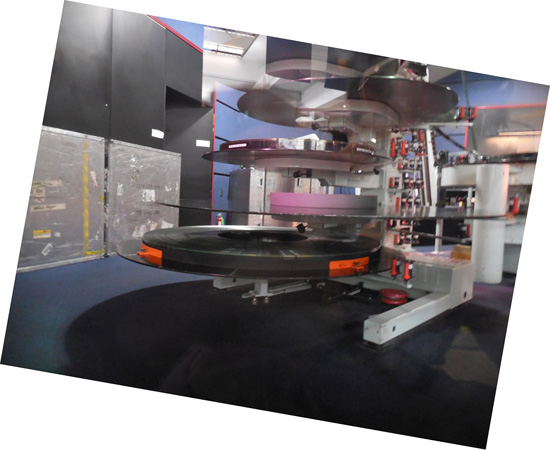 "Dunkirk"
in 70mm IMAX at Franklin Institute, Philadelphia. Image: Howard B Haas "Dunkirk"
in 70mm IMAX at Franklin Institute, Philadelphia. Image: Howard B HaasThe Mole: One Week Just as the action in the story spans different time frames on land, sea and air, filming on “Dunkirk” also encompassed all three realms. One of the most impactful creative decisions made by the filmmakers was to concentrate the land-based filming at the exact place where the momentous events occurred nearly eight decades ago. During pre-production, Nolan, Thomas and production designer Nathan Crowley visited Dunkirk together. “At first, we didn’t necessarily think we were going to shoot there and we did explore other possibilities,” says Nolan. “But seeing the reality of the place and the unique quality of its geography made it inevitable that we would film there, whatever the challenges might be. So we just dove in.” One of the first tasks involved in readying the historic beach for filming was certainly unique to the location. Prior to filming, they swept the area for any unexploded ordinance that might have remained long-buried in the sand. Executive producer Jake Myers shares, “We knew our special effects team would be setting off controlled explosions there, so we had to do careful surveys and check for anything, even a stray bullet. Fortunately,” he smiles, “nothing showed up.” Yet by far the biggest task at Dunkirk was restoring what remained of the eastern mole to its 1940 form. Crowley says, “I remember standing there on the beach thinking, ‘Oh God, we’ve got to build an entire pier.’ A mole is a stone breakwater, and they had put a white, wooden structure on top of it to off-load ships back in the toll-ship era. That’s what we had to replicate.” The restoration had a profound impact on historian Joshua Levine. “To witness the rebuilding that went on at Dunkirk, to make it temporarily what it had been in 1940, was an enormously emotional experience,” he says. “It was very moving, very affecting, and I think very important.” “We had to rebuild the mole because it’s a distinctive feature of Dunkirk,” notes Thomas. “And it played a vital role in the evacuation, because the beach itself is extremely shallow, making it impossible for big ships to get to the shore. So the soldiers crowded onto this narrow breakwater, which, when you see photos, is an amazing visual.” Myers adds, “Thousands pushed their way onto this little sliver that juts out into the ocean and basically stood there, completely vulnerable to aerial assault.” The production’s restored mole was also vulnerable to attack, but from nature. In order to enable their mole to withstand the force of the ocean, Crowley’s art department had it constructed with 14x14-inch timbers for its legs, using a crane barge to slowly build it out to sea. “There was about 600 feet of existing pier construction, and then we had to add about 500 feet,” says the production designer. “It was a major undertaking that required the help of the city, the port authority, the port engineers, and dredging companies. And because we try to do things in camera, that also meant getting ships to agree to moor on a set structure. It was very tough to film practically.” The weather also proved challenging, to the surprise of the filmmakers who had hopes that early summer on the coast of France would be beautiful. Part of the filming schedule coincided with the anniversary dates of the actual evacuation, from May 27th to June 4th. But while the most crucial days of the real 1940 evacuation were remarkably calm, the “Dunkirk” shoot was hit by some truly terrible weather. One storm was so bad that it caused the waves to tear strips from the production-built mole. “When the wind blew, the waves just hammered it,” says special effects supervisor Scott Fisher. “The timbers were massive and the structure was engineered to withstand a lot of punishment, but the weather was well beyond what we anticipated. With the constant pounding of the waves, pieces started peeling off and deck boards started coming up.” Thomas recalls, “We ended up on various occasions coming in in the morning and finding that bits of our mole had washed away overnight.” |
|
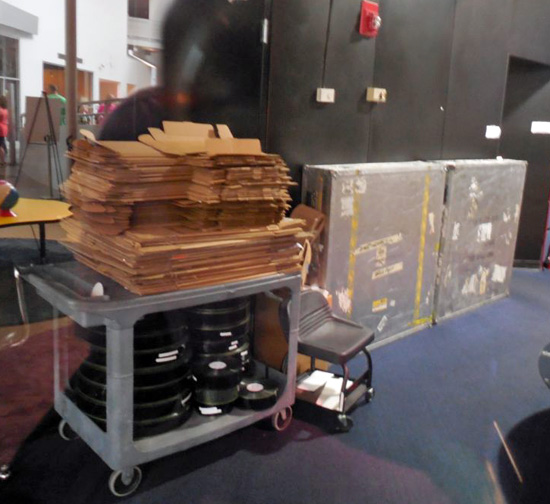 "Dunkirk"
in 70mm IMAX at Franklin Institute, Philadelphia. Image: Howard B Haas "Dunkirk"
in 70mm IMAX at Franklin Institute, Philadelphia. Image: Howard B Haas“The sea was pretty rough,” Crowley affirms. “The only plus was that every time the water peeled boards off the mole, it would always deposit them on the same bit of beach. So we knew where all our parts were, and could go and get them and put them back on. It was a constant repair job.” Apart from the mole, Crowley’s team also had to recreate an entirely different type of water access. “One thing the soldiers did at the time was build these makeshift piers out of trucks—driving them out into the water and lining them up,” Crowley illustrates. “So we ended up building a truck pier, too…and learned the difficulty of building a truck pier,” he deadpans. Weather wasn’t the only thing that hampered filming on the shoreline. The tide was almost as much of an obstacle for the production as it had been for the evacuating army in 1940. Nolan confirms, “The tide—as indeed with the original events in the film—was a major factor because the swing of the tide is colossal in Dunkirk.” Rapidly shifting weather conditions also had implications for continuity. Cinematographer Hoyte van Hoytema notes, “The North Sea in that part of France is very overcast, with low-hanging clouds that are ever-changing. The sun can break through one moment, and the next you’re in fog. It’s a very dynamic weather system. If you’re looking for something that appears consistent and precise throughout every shot, you’re pretty much chasing your tail. But because this story jumps between these different timelines, we were able to incorporate that constantly changing light.” As long as it was safe, Nolan was always game to take advantage of the inclement atmosphere. “The irony is I’ve been told that I’m known for having good luck with weather, but truly I have the worst luck with weather,” the director laughs. “You just have to embrace it, and in that sense, you make your own luck. In truth, some of the best-looking material you ever get is shot under the harshest conditions.” Cast and crew alike appreciated that Nolan was always out there in the thick of things, braving the elements alongside them. “Chris doesn’t sit down!” Harry Styles marvels. “Any time there was a break, it was because he knew everyone else needed one. He wasn’t sitting in some warm tent watching everything on a monitor. He’s out there mucking in with everyone else. I was in awe.” Aneurin Barnard comments, “To put something like this together is something like a military operation in and of itself. The scale of it was quite remarkable, and it was a test, with the weather, the explosions, and all the action.” |
|
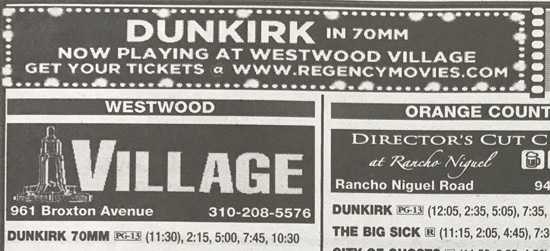 No
Dunkirk display advertisement published in Los Angeles Times. Only a couple
of text-based ads mentions 70mm. Spotted by Mike Coate. No
Dunkirk display advertisement published in Los Angeles Times. Only a couple
of text-based ads mentions 70mm. Spotted by Mike Coate.With the cast and thousands of extras on the beach, Fisher and his special effects team had to carefully plan the explosions resulting from the bombing runs on the trapped soldiers. “It’s a sandy beach, but there were a lot of rocks and debris in it,” Fisher says. “For safety, we would go out and dig holes and then set our charges in. And then we used clean, sifted sand to fill over the top so there wouldn’t be any rocks flying out of there when the blasts went off.” Putting the cast and all the extras in uniform was a colossal task for costume designer Jeffrey Kurland and his department, beginning with extensive research. He says, “We looked through books and went on eBay and bought old magazines from the period. We also watched the old news reels and found some amazing firsthand accounts. We gathered a great deal of research and then shared it throughout the entire crew, not just in my department, because we were all in earnest about wanting to do this thing right.” That attention to detail was not lost on the cast. Styles shares, “The first day, I put my uniform on and walked out and Chris checks me over and says, ‘Your boots are laced wrong.’ He explained that the British soldiers did them looped rather than criss-cross. He had researched everything about Dunkirk to the nth degree. It was just exciting to be involved in something like this, where we were all working toward the same end.” |
|
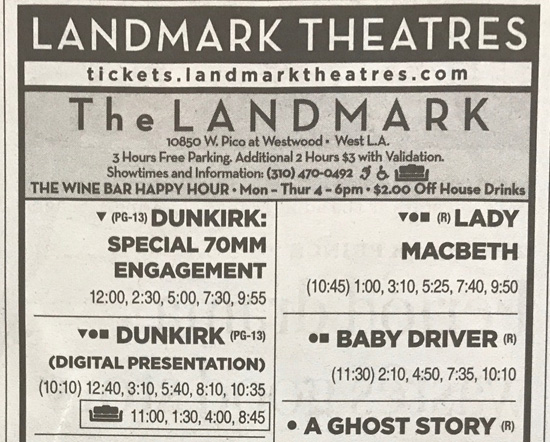 No
Dunkirk display advertisement published in Los Angeles Times. Only a couple
of text-based ads mentions 70mm. Spotted by Mike Coate. No
Dunkirk display advertisement published in Los Angeles Times. Only a couple
of text-based ads mentions 70mm. Spotted by Mike Coate.The main challenge for Kurland’s team was that every item of clothing had to be made from scratch. “We didn’t rent anything, because we were afraid that we would ruin too many pieces, so everything had to be created,” Kurland explains. “But because we owned everything, we could do anything to it we wanted to. We milled the wool to make the uniforms, and then the nap of the fabric had to be shaved down because the tone did not match what Chris was looking for. I also wanted to make the wool a bit thinner, so we had to dampen each individual piece and then carefully take it down with a blow torch. And then we went in and aged it on top of that. It was a huge process that took a great deal of time.” Most of the extras came from the town of Dunkirk and the surrounding area, “so not just the town itself played a part in the film, but the residents, too,” says Thomas. “The mayor lent us an enormous amount of support in every way. “It’s quite something, being in that place,” Thomas goes on to reflect. “To this day there are reminders of the events of 1940 that show themselves all the time. When the tide is particularly low you can still see a shipwreck of a boat that went down right next to the mole. And buttons and buckles from soldiers’ uniforms are still being found. It’s really incredible.” Shooting in Dunkirk made a strong impression on the actors playing the soldiers. More than anything, it truly brought home to them just how it must have been for those young men on the beach nearly eight decades ago. Fionn Whitehead relates, “There were definitely days where I was pretty beaten. There was a driving rain, it was freezing, the wind was very strong, and we were all soaked through. We had our period uniforms on, which were made of wool, so they just soaked up all the water. It was so unbelievably miserable,” he admits. “But then I became overwhelmed by the realness of the situation for the soldiers at the time. It was so easy to imagine when you came out onto the beach and the water was coming in and explosions were going off... That really brought it home. It was no longer just a story. I was able to empathize with the soldiers in a way I never had before. It made me realize how terrible it was for them and the real struggle they had.” That empathy was shared by the filmmakers. “The moments where it really hit home for me,” Thomas shares, “were when I was feeling worn down by the physicality of being out in the elements on that beach for days on end. But of course, no one was attacking me, and I was able to go back to a nice warm bed at night. It was a reminder of what those men had been through on that beach.” |
|
ON THE WATER |
|
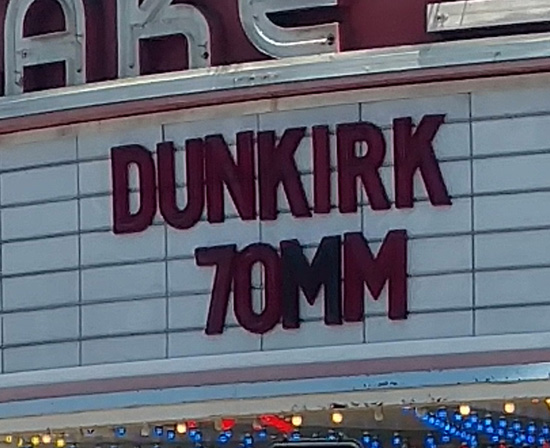 Dunkirk
in 70mm on the Grand Lake in Oakland, USA. Image: Tyler Brady Dunkirk
in 70mm on the Grand Lake in Oakland, USA. Image: Tyler Brady
The Sea: One Day While some of the water sequences were filmed near Dunkirk in the English Channel, most of the Moonstone scenes were shot in the Netherlands on a shallow artificial lake called Ijsselmeer. Nolan offers, “At Hoyte’s suggestion, we had gone to Ijsselmeer, which is non-tidal, so we could anchor sets to the bottom without having to worry about the tide coming in and out. The depth is between 12 and 14 feet and it looks like open water and rolls the way the sea does, though generally a little calmer.” In preparation for the water shoot, Nolan organized several scout trips with his key crew. The director says, “We really experienced the movement of the boats and talked in great detail about how that would photograph. The basic philosophy that emerged was to shoot with as much handheld camera as possible, because when you have a great handheld cameraman like Hoyte, he is your most stable and versatile camera platform on a boat going up and down with the waves. And we would do that in combination with a very efficient camera boat that could keep pace with the other boats so we could shoot boat-to-boat in a very versatile way as well. Those became our two most important approaches for how to work on water.” The camera boat used for “Dunkirk” was an ingenious adaptation of equipment Nolan had used for car sequences in his “Dark Knight” movies, called the Edge. Myers describes, “It’s a crane mounted to a Mercedes SUV. We wanted to create a boat equivalent of that, so we found a big catamaran and mounted this 26-foot-long, gyro-stabilized, telescopic crane to the front of it. It was very nimble and could turn and maneuver easily while holding the IMAX cameras, allowing them to be as close to the water level as possible. We used this platform to shoot virtually everything at sea.” The film presented Edge coordinator Dean Bailey—more used to working on cars—with some interesting trials. “Everything is slower in a boat,” he remarks. “You can’t hold your position; the wind affects you, as do the waves, the tide, the currents… And the system was wet every day for almost two months. But we designed it to be waterproof and to sustain that pounding day in, and day out.” “This was the first time the Edge guys had mounted the crane on such a large craft in a way that it had great access to the water,” says NoIan. “It was a very robust camera platform in that it could go out in very challenging conditions.” |
|
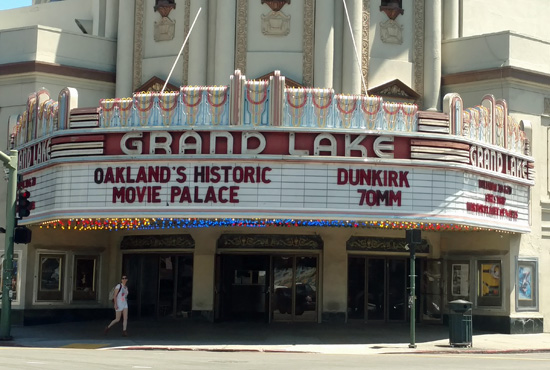 Dunkirk
in 70mm on the Grand Lake in Oakland, USA. Image: Tyler Brady Dunkirk
in 70mm on the Grand Lake in Oakland, USA. Image: Tyler BradyTo help gather all the ships and boats required for the production, Nathan Crowley worked with experienced marine coordinator Neil Andrea to track down dozens of surviving vessels from the period, from nine different countries. They included three minesweepers, a hospital ship and a 350-foot-long French destroyer named the Maillé-Brézé, which, because it no longer had an engine, was tugged up from Nantes, where she’d rested as a museum ship since 1991. The last provides one of the film’s most striking visuals, “where the Moonstone sails alongside the big destroyer with hundreds of soldiers standing on its deck,” Thomas says. “I think it’s one of the moments in ‘Dunkirk’ that really resonates with me because it sums up the amazing nature of the story—the idea that regular people on pleasure boats managed to make a real difference for the military.” The production purchased a quaint 40-foot yacht, built in 1939, to serve as Mr. Dawson’s Moonstone. Andrea says, “We bought the boat because that gave us the latitude to do whatever we needed to do with it, with cast, crew and IMAX cameras on it.” Mark Rylance, who shot almost all his scenes on the Moonstone, became particularly enamored of his character’s vessel. “I really fell in love with her,” he confirms. “I spent many hours sitting down in the cabin. She’s got a beautiful cabin, which the wonderful art department decorated with little books on the shelf and all this old stuff from the period. Even when you opened the drawers, they had these beautiful old tins and things from the 1940s. But she didn’t have a deep keel, so she rocked about like anything in the water.” “I definitely had to get used to it,” Barry Keoghan remembers. “I was kind of nervous the first few days until I found my sea legs. We spent a lot of time just hanging about on the Moonstone and all got very comfortable walking up and down on deck. Chris wanted us to feel like we owned that boat, and I think that will show.” Van Hoytema reveals that the biggest issue for him was shouldering the heavy, large-format cameras on the small, pitching deck. “It was not a walk in the park,” the cinematographer allows. “It was cramped and it was very hard to hold the camera in the waves. But I had this wonderful key grip, Ryan Monro, who was pretty much my right hand in terms of camera support. He would rig himself into a harness, which he would attach via cables to eyelets on the hull of the boat, and stand next to me and help support the camera. We developed a symbiotic way to enable me to stand freely and keep balance so I could operate the camera.” |
|
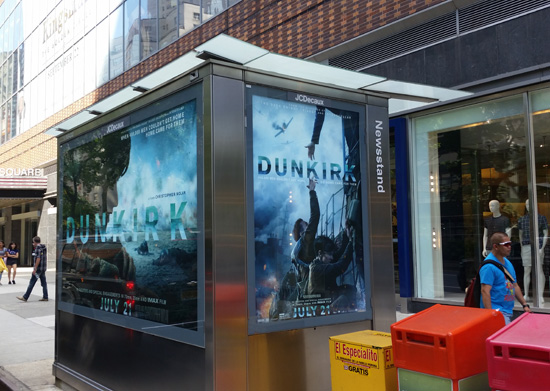 "Dunkirk"
in New York. Image by Dennis Furbush "Dunkirk"
in New York. Image by Dennis Furbush“It could be grueling,” Nolan acknowledges, “but it was fun as well because it gets back to the type of filmmaking that Hoyte and I like the most, and I believe the actors also like the most—absolute minimal crew, in the moment, there in the elements.” Filming scenes in the Channel or on the lake meant that other departments also had to be out on the water, forming their own flotilla. In addition to the camera boats, there were safety boats, makeup and hair boats, wardrobe boats and more. Even meals had to be ferried out to the cast and crew. But unlike a land-based production, it wasn’t so easy to move out of the way when Nolan moved the camera for a different angle. Thomas notes, “Every time you shot in a certain direction, all those boats would have to move so they were out of the shot, and that was a remarkable thing to get a glimpse of.” On the production’s biggest day at sea—during the week they filmed the little ships’ crossing—there were as many as 62 boats gathered on the English Channel. The filmmakers were extremely gratified that among them were some of the boats that had actually sailed from England in 1940 to rescue the men from the Dunkirk beach, and have been maintained ever since by the Association of Dunkirk Little Ships. The ships recreating their courageous and historic journey for the film were the Caronia, Elvin, Endeavour, Hilfranor, Mary Jane, Mimosa, MTB 102, New Britannic, Nyula, Papillon, Princess Elizabeth, and RIIS I. Some of the ships acquired for the film were repurposed in inventive ways. The minesweepers, for example, were dressed by Crowley’s team to look like destroyers in background shots. Crowley remarks, “We also got an old Coast Guard ship from Rotterdam, which was about 200 feet long, to which we added scaled-down guns and towers and clad the exterior to give it a destroyer profile.” However, not everything could be achieved on the waters of the Channel or Ijsselmeer. Fisher explains, “We built gimbals on Stage 16 at Warner Bros., which has one of the largest water tanks in the world. We used it for interiors of ships that required some effects with hulls buckling, and things like that. We also did some exteriors at Falls Lake at Universal Studios, where we shot the sinking of a 120,000-pound ship.” |
|
TAKING WING |
|
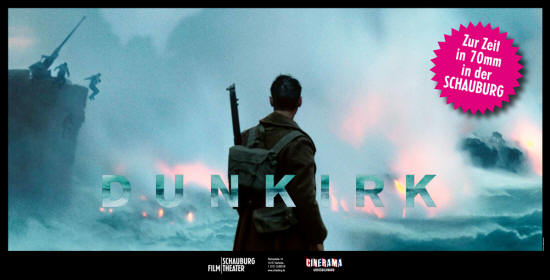 XL
sized "Dunkirk" banners (3,5 x 1,7 meters), printed for outdoor use at
Schauburg Cinerama's Open Air showings i Karlsruhe, Germany. XL
sized "Dunkirk" banners (3,5 x 1,7 meters), printed for outdoor use at
Schauburg Cinerama's Open Air showings i Karlsruhe, Germany.Click to see larger version The Air: One Hour As the Moonstone makes its crossing to Dunkirk, Mr. Dawson, Peter and George are thrilled to see an RAF Spitfire flying overhead. But for the actors, this was no visual effect: three vintage Spitfires were filmed soaring in the skies above the Channel. Tom Glynn-Carney says it did not require much acting to be awed by the sight. “Playing in those situations, literally all you had to do was watch what was happening. It was just insane to have Spitfires flying a few feet above your head. When do you ever get to see something like that? It was a once-in-a-lifetime opportunity!” During pre-production Nolan went for his own flight in a Spitfire, and urged both van Hoytema and Crowley to do so as well to truly feel the dynamics of the magnificent planes that helped defend the men at Dunkirk. “When you go up in a Spitfire, which I was lucky enough to do,” Nolan says, “you get an extraordinary degree of respect for the people who were flying those planes and enduring the conditions. I mean, it’s very exciting, but it is not a comfortable machine to be in. The degree of physical stamina and concentration—in addition to the obvious courage that the pilots had to have—became a fascinating thing to portray.” To capture the film’s furiously intense aerial engagements, Nolan again pushed the envelope on what could be achieved practically, especially with large-format cameras. He remarks, “In today’s era, with GoPro cameras and the like, people are getting very used to seeing extreme physical events from very interesting subjective angles. As a filmmaker, that raises the bar in terms of trying to depict planes from 1940 in a way that modern audiences can respond to. We wanted to show everything from the pilots’ point of view, but still using IMAX cameras. It was a major challenge to have that huge camera in the cockpit of the Spitfire, but we were determined to do it.” |
|
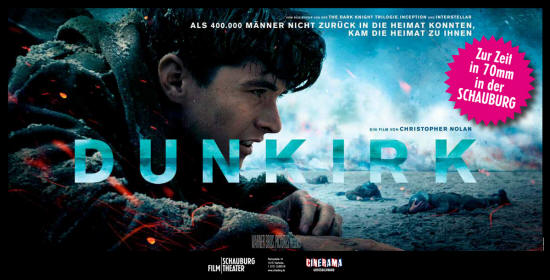 XL
sized "Dunkirk" banners (3,5 x 1,7 meters), printed for outdoor use at
Schauburg Cinerama's Open Air showings i Karlsruhe, Germany. XL
sized "Dunkirk" banners (3,5 x 1,7 meters), printed for outdoor use at
Schauburg Cinerama's Open Air showings i Karlsruhe, Germany.Click to see larger version The first step was obtaining the planes. Nathan Crowley secured three Spitfires—two Mark 1s and one Mark 5—as well as a Spanish HA-1112 Buchón to double for the German ME-109s, better known as Messerschmitts. However, Nolan acknowledges, “We did take certain liberties with historical accuracy for narrative reasons. For example, our ME-109 Messerschmitts have yellow noses, when at that point, they had not yet started to paint the ME-109s like that. But it allows the audience to more easily distinguish the enemy from the Spitfires.” In addition, stunt coordinator Tom Struthers came up with the idea of utilizing a Yak-52, a two-seater Soviet aircraft that is similar enough to the Spitfire that Crowley’s team could dress it as one of the iconic British fighter planes for close-up shots of the actors in the cockpit. To shoot these action sequences, van Hoytema worked with the man he calls Panavision’s “lens guru,” Dan Sasaki, to devise a pivoting, periscope-style lens that enabled him to fit the large IMAX camera vertically into restricted cockpit spaces. With that, they could shoot the pilot’s line of sight, looking through the canopy. “The intimate physicality of that tiny cockpit… We really focused on that being one of the most important aspects of the film—putting the audience in that seat. It was an extremely difficult thing to do,” says Nolan. Van Hoytema also recruited aerial engineer Andy McCluskie to build a rig that allowed an IMAX camera to be safely mounted on the Yak. Nolan details, “We adapted our Yak to provide a camera platform, enabling us to take our actors up for closeups from different angles, using different camera mounts, while actually in the air. We wanted to get that feeling of really being in a dogfight.” |
|
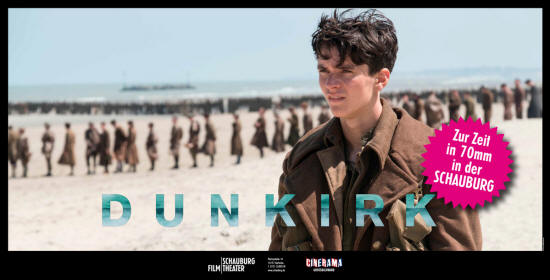 XL
sized "Dunkirk" banners (3,5 x 1,7 meters), printed for outdoor use at
Schauburg Cinerama's Open Air showings i Karlsruhe, Germany. XL
sized "Dunkirk" banners (3,5 x 1,7 meters), printed for outdoor use at
Schauburg Cinerama's Open Air showings i Karlsruhe, Germany.Click to see larger version For Jack Lowden, shooting scenes in flight was nothing short of exhilarating. “Making this film was the whole package for me. I’ve been up in the air in a Yak. I’ve been swooping around over the Channel with real Spitfires… I said to Chris, ‘This is gonna make every other job I do boring,’” he laughs. The other camera aircraft employed during production were a helicopter and the Aerostar camera plane. Aerial director of photography Hans Bjerno points out, “The limiting factor with the helicopter is speed. It can only go at 120 miles per hour, whereas the Spitfires fly at 200 miles per hour. So, with that, you’re basically an eye in the sky, watching the airplanes go through. But the Aerostar can go at the same speed.” The dogfights in “Dunkirk” required the pilots actually flying the various aircraft to choreograph tightly all the maneuvers. Nolan attests, “Because of the speeds at which things happened, our real pilots needed to take a lot of time on the ground to really plan things and prepare. Once you get up in the air, communication—particularly with these older aircraft, which are very noisy—can be difficult.” The first step was for visual effects supervisor Andrew Jackson to map out with Nolan how each aerial sequence would play out. “We started working quite early on,” says Jackson, “laying out exactly what the planes were doing during each of the air battles using computer pre-visualization. That meant we started the film with a broad sketch of what the overall action would be.” Using that as their guide, the pilots discussed each aerial scene with Nolan and van Hoytema before take-off. “We talked about how we saw it playing out and what we thought the shot should be,” says Nolan. “Then the pilots would talk among themselves and walk a pattern, literally pretending to be airplanes. Sometimes they’d even hold their hands out like wings. At first, for an outsider looking at the process, it seemed an odd way to approach it. But you rapidly realize after doing a couple of flights with these guys that it’s an incredibly precise and smart way to make sure that everybody on the team knows exactly where they’re meant to be, and at what point.” |
|
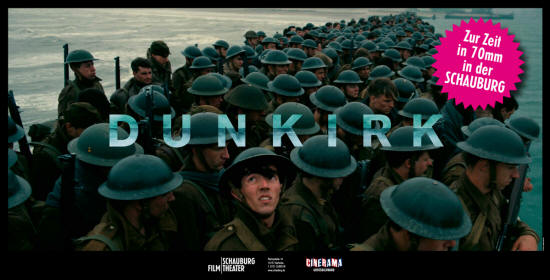 XL
sized "Dunkirk" banners (3,5 x 1,7 meters), printed for outdoor use at
Schauburg Cinerama's Open Air showings i Karlsruhe, Germany. XL
sized "Dunkirk" banners (3,5 x 1,7 meters), printed for outdoor use at
Schauburg Cinerama's Open Air showings i Karlsruhe, Germany.Click to see larger version Jackson also spent time with the aerial unit shooting airplanes and cockpit point-of-view shots through the gun sights. “We put cameras inside the canopies of the planes and moved them around to get sun flares and other atmospheric effects,” he says. “Those elements could then be composited on top of the real planes we flew.” While tremendous strides were made in capturing the aerial footage, not all the cockpit scenes with Hardy and Lowden could be achieved in flight. “There were certain shots we knew we’d have to get on a set,” says Thomas, “so the art department built an amazing gimbal with a cockpit of a Spitfire on it that Chris was able to manually control himself.” Nevertheless, the director insists, “We took the view of not using any green screens or blue screens. We wanted to shoot the scenes in a way that there was always a background of real water at an appropriate altitude, with real sky and natural lighting.” To accomplish this, the production was given permission to place their gimbal at a U.S. Coast Guard facility on a sea cliff in Palos Verdes, California. “Having a high-altitude platform where we could film the actors ‘flying’ the plane gave us a base level of reality to intercut with the real air-to-air photography. In that way, we could create a consistency with the dogfight sequences,” Nolan offers. |
|
ECHOES OF DUNKIRK |
|
 "Dunkirk"
in Berlin. Image by Gerhard Witte "Dunkirk"
in Berlin. Image by Gerhard WitteWhen principal photography on “Dunkirk” wrapped, Nolan reunited with two longtime collaborators, editor Lee Smith and composer Hans Zimmer, to complete his epic thriller. Sound and music merged to underscore the race against time. Nolan offers, “The unusual rhythm of the script needed to be amplified by the music. The score plays in the film as one long piece with a unifying and complex tonal structure. Sound effects and the varying time scales of the story are woven into the fabric of Hans’s music.” Sound designer and supervising sound editor Richard King recorded the motor of the Moonstone, as well as other ships, “and then all that was sent through to Hans Zimmer’s facility,” Smith explicates. “They sampled them in such a way that the engine sounds are always accelerating. Also, Hans recorded the ticking of Chris’s watch, which was synthesized. In combination with the music, it all has an incredible drive to it.” Adding to the suspense, Nolan and Zimmer also implemented a variation on a shepherd tone—a technique that creates the auditory illusion of a tone that’s continually ascending in pitch. At Nolan’s suggestion, Zimmer blended into his score an adaptation of “Nimrod,” Edward Elgar’s soaring theme, which Nolan describes as being “as beloved to the English as the story of Dunkirk itself.” Zimmer brought in composer and orchestrator Benjamin Wallfisch who, together with Nolan and music editor Alex Gibson, “fashioned a modern reworking that grows out of the sights and sounds of the movie,” the director notes. “Hans’s own brass accents intensify the power of the piece. We wanted the score to echo the circumstances of the event we are honoring—a story of survival, and a triumph of a communal effort, as opposed to the heroism of any one individual. |
|
 "Dunkirk"
at the Rex in Paris. Image by Grand Rex "Dunkirk"
at the Rex in Paris. Image by Grand Rex“The events of Dunkirk are sacred ground,” Nolan reflects, “not to be ventured onto without great care. It’s daunting for a filmmaker, but also irresistible. There were moments when I looked at the very large re-creation of events we pulled off—the real little ships arriving, with naval destroyers in the sea, and rebuilding the mole—and it felt quite extraordinary. To have that many different elements come together definitely made a lasting impression on me.” Yet the filmmakers agree that their first priority was always to entertain, and every creative decision Nolan made was intended to transport audiences to that place and time. “The thing Chris does in his movies, which I really appreciate, is that when you watch them in the cinema, you’re experiencing something you couldn’t really experience anywhere else,” Thomas states. “We want to put people on the beach at Dunkirk, on the deck of the Moonstone and in the cockpit of a Spitfire,” Nolan concludes. “We want to take the audience on a very intense ride. That’s the experience we want to give the audience—to make them feel that they’re actually there and allow them to feel what that would be like.” |
|
ABOUT THE CAST |
|
 Mr.
Nolan at "Dunkirk" premiere at the Rex in Paris. Image by Grand Rex Mr.
Nolan at "Dunkirk" premiere at the Rex in Paris. Image by Grand RexFIONN WHITEHEAD (Tommy) makes his feature film debut in “Dunkirk.” He will next be seen on the big screen in the drama “The Children Act,” directed by Richard Eyre and starring Emma Thompson and Stanley Tucci. On television, Whitehead starred in the title role of the 2016 ITV miniseries “Him.” Earlier this year, he earned critical acclaim for his performance in Glenn Waldron’s play “Natives,” presented at the Southwark Playhouse. This July, Whitehead will star in the Old Vic Theatre production of “Queers.” TOM GLYNN-CARNEY (Peter) makes his feature film debut in “Dunkirk.” Glynn-Carney can currently be seen at the Royal Court Theatre in “The Ferryman,” directed by Sam Mendes. The Royal Court run sold out in one day, making it the fastest-selling play in the history of the theatre. In June, the widely acclaimed production transferred to the West End for a 16-week run at the Gielgud Theatre. Written by Jez Butterworth, the play also stars Paddy Considine and Laura Donnelly. This summer, Glynn-Carney also stars in Peter Moffat’s “The Last Post,” for the BBC One. Set in 1965, the series also stars Jessica Raine, Ben Miles and Stephen Campbell Moore. Glynn-Carney trained at the Guildhall School of Music & Drama and began his career on the stage. His credits include “Peter Pan” at the Lyric Theatre Lowry, and “Macbeth” at the Royal Exchange Theatre in Manchester. While at Guildhall, he also starred in a number of in-house productions, including “Richard II,” “Into the Woods,” “The Apple Cart” and “Oedipus Rex.” JACK LOWDEN (Collins) is an award-winning stage actor who has gained attention for his recent work in several film and television projects. Following “Dunkirk,” Lowden has leading roles in a number of diverse features. He stars as Steven Patrick Morrissey in the Mark Gill-directed biopic “England is Mine,” which chronicles Morrissey’s early life before going on to become the lead singer of the ‘80s band The Smiths. The film, also starring Jessica Brown Findlay, will close the Edinburgh International Film Festival in July. His upcoming films also include Stephen Merchant’s wrestling comedy-drama “Fighting with My Family,” alongside Dwayne Johnson, Lena Headey, Vince Vaughn and Florence Pugh; and the romantic drama “Cross My Mind,” in which he stars opposite Sally Hawkins under the direction of János Szász. He will also star in Josie Rourke’s “Mary Queen of Scots,” based on John Guy’s acclaimed biography Queen of Scots: The True Life of Mary Stuart. Lowden will portray Lord Darnley, opposite Saoirse Ronan in the title role and Margot Robbie as Queen Elizabeth I. Lowden also recently starred as legendary Scottish golfing champion Tommy Morris in “Tommy’s Honour.” The film premiered at the 2016 Edinburgh Film Festival and opened in the U.S. in April 2017. His previous film credits include “Denial” and “A United Kingdom,” which both premiered at the 2016 Toronto International Film Festival; and “U Want Me 2 Kill Him?” which marked his film debut. |
|
 "Dunkirk"
premiere at the Rex in Paris. Image by Grand Rex "Dunkirk"
premiere at the Rex in Paris. Image by Grand RexOn television, Lowden starred last year as Nikolai Rostov in “War & Peace,” A&E’s ambitious miniseries adaptation of Tolstoy’s classic, directed by Tom Harper. He previously appeared in the PBS miniseries “Wolf Hall”; the WWI-set miniseries “The Passing Bells”; and the series “The Tunnel” and “Mrs Biggs.” On the stage, Lowden won an Olivier Award and an Ian Charleson Award for his performance as Oswald in Richard Eyre’s 2013 revival of Ibsen’s “Ghosts.” That same year, he played Orestes in “Electra” at the Old Vic. In 2013, he starred as Scottish runner and missionary Eric Liddell in the stage adaptation of the Oscar-winning film “Chariots of Fire.” A graduate of the Scottish Royal Academy of Music and Drama, Lowden first gained attention with his breakthrough role in The National Theatre of Scotland’s 2010 revival of “Black Watch.” Lowden received widespread critical acclaim when the production toured the UK and then several cities in the U.S., including New York and Chicago. HARRY STYLES (Alex) makes his acting debut in “Dunkirk.” Styles also just made his solo music debut with his self-titled debut album, released in May. The 10-track album features the lead single “Sign of the Times,” which topped the iTunes charts in over 84 countries upon release day. The album made history with the biggest debut sales week for a U.K. male artist’s first full-length album since Nielsen Music began tracking sales in 1991, and it topped official charts at #1 in more than 55 countries. In support of the new music, he made acclaimed appearances on “Saturday Night Live,” including performing in multiple comedy sketches; “The Graham Norton Show”; and a week-long residency on “The Late Late Show with James Corden.” In the fall, Styles will embark on a sold-out world tour, performing in intimate venues across 13 U.S. cities before heading to Europe and wrapping in Japan. As the star of the global phenomenon One Direction, Styles became one of the best-known musicians in the world. With the group, Styles sold more than 65 million records worldwide, achieved a total of 137 number ones, and won five Billboard Music Awards, four MTV Video Music Awards, and five American Music Awards. One Direction was the first band in history to have its first four albums debut at number one on the Billboard 200 charts. ANEURIN BARNARD (Gibson), an Olivier Award winner, is one of the industry’s most promising young actors, with roles in several critically acclaimed film, television and theatre productions to his credit. “Dunkirk” marks his first major studio release. Upcoming, Barnard stars in Tom Edmunds’ independent comedy feature “Dead in a Week: Or Your Money Back,” alongside Tom Wilkinson and Marion Bailey. Earlier this year, he starred as Wolfgang Amadeus Mozart in John Stephenson’s “Interlude in Prague,” also starring James Purefoy and Samantha Barks; and George Mendeluk’s “Bitter Harvest,” also with Barks, as well as Terence Stamp and Max Irons. His previous film credits include leading roles in “The Truth About Emanuel”; “The Adventurer: The Curse of the Midas Box”; “Mary Queen of Scots”; “Trap for Cinderella”; the award-winning “Citadel,” for which Barnard won the Best Actor Award at the 2012 Puchon International Film Festival; “Hunky Dory,” in which he also showcased his singing talents; and “Ironclad.” Barnard has also been recognized for his work on the small screen. He was seen earlier this year in the BBC miniseries “SS-GB,” a dystopian drama based on Len Deighton’s 1978 novel. Last year, he starred in two very different BBC miniseries “War & Peace,” adapted from Tolstoy’s classic novel, for which he earned a Welsh BAFTA Award nomination for Best Actor; and “Thirteen.” In addition, he has had starring roles in such notable television projects as “The Scandalous Lady W,” “Killing Jesus,” “Cilla,” “Moonfleet,” “The White Queen,” and “We’ll Take Manhattan.” A graduate of the Royal Welsh College of Music and Drama, Barnard first gained attention playing the lead role of Melchior Gabor in the Tony Award-winning musical “Spring Awakening.” For his performance, he won a 2010 Olivier Award for Best Actor in a Musical. He was also named a Star of Tomorrow by trade publication Screen International. JAMES D'ARCY (Colonel Winnant) will next be seen in Tomas Alfredson’s crime drama “The Snowman,” with Michael Fassbender and J.K. Simmons. The film is slated for release in Fall 2017. His additional feature film credits include James McTeigue’s thriller “Survivor”; the comedy “Let’s Be Cops,” opposite Damon Wayans Jr. and Jake Johnson; “Jupiter Ascending” and “Cloud Atlas,” both for the Wachowskis; the biopic “Hitchcock,” opposite Anthony Hopkins; the historical drama “W.E.”; and Peter Weir’s “Master and Commander: The Far Side of the World.” On the small screen, D’Arcy played leading roles in ABC’s “Agent Carter,” opposite Hayley Atwell, and A&E’s serial killer drama “Those Who Kill,” alongside Chloë Sevigny. He was also seen as the villain in season 2 of the critically acclaimed UK series “Broadchurch.” BARRY KEOGHAN (George) stars with Colin Farrell and Nicole Kidman in Yorgos Lanthimos’s drama “The Killing of a Sacred Deer.” The film just premiered to great acclaim at the 2017 Cannes Film Festival and will also screen at the Toronto International Film Festival. It is slated for release this fall. Also upcoming, Keoghan stars in Bart Layton’s independent feature “American Animals.” His previous credits include Konstantin Bojanov’s “Light Thereafter”; Adam Smith’s “Trespass Against Us,” with Michael Fassbender and Brendan Gleeson; “Traders”; Martin Radich’s “Norfolk”; “Stay”; and Yann Demange’s award-winning “`71,” opposite Jack O’Connell. Born and raised in Dublin, Ireland, Keoghan first gained attention for his role on the Irish television series “Love/Hate.” He went on to become one of Screen International’s Stars of Tomorrow in 2015, and one year later was the breakout star of the 2016 Sundance Film Festival for his performance in Rebecca Daly’s “Mammal,” opposite Rachel Griffiths. Most recently, the Hollywood Reporter picked Keoghan as their Cannes: Next Big Thing recipient. |
|
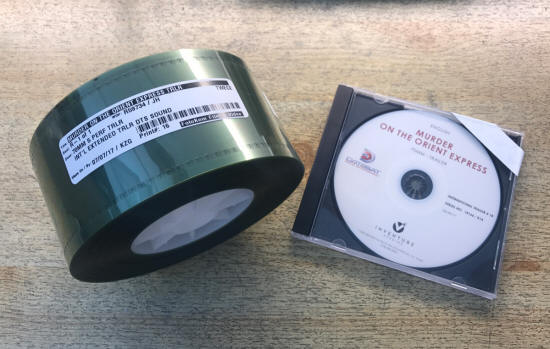 70mm
trailer for "Murder on the Orient Express" by Kenneth Branagh. Picture by
Herbert Born 70mm
trailer for "Murder on the Orient Express" by Kenneth Branagh. Picture by
Herbert BornKENNETH BRANAGH (Commander Bolton) is one of the world’s most consistently acclaimed filmmakers and actors. He is currently directing the upcoming “Murder on the Orient Express,” adapted from Agatha Christie’s novel and due out on November 10, 2017. He also plays Hercule Poirot in the film, joining an all-star cast also including Johnny Depp, Penélope Cruz, Michelle Pfeiffer and Judi Dench. In 2016, The Kenneth Branagh Theatre Company completed its successful inaugural season of Plays at the Garrick Theatre in London’s West End. Their productions included Shakespeare’s “The Winter’s Tale,” co-directed by Branagh, who played Leontes opposite Judi Dench; Terence Rattigan’s “Harlequinade” and “All on Her Own”; Francis Veber’s “The Painkiller,” directed by Sean Foley with Branagh starring opposite Rob Brydon; Lolita Chakrabarti’s “Red Velvet”; Shakespeare’s “Romeo and Juliet,” co-directed by Rob Ashford and Branagh; and John Osborne’s “The Entertainer,” directed by Ashford with Branagh playing the lead role of Archie Rice. For the screen, Branagh recently directed the live-action “Cinderella,” starring Cate Blanchett, Lily James, Richard Madden and Helena Bonham Carter. Released in March 2015, it went on to gross over $540 million. He previously directed the latest installment of Tom Clancy’s Jack Ryan franchise, “Jack Ryan: Shadow Recruit,” in which he also starred alongside Chris Pine and Keira Knightley. Additionally, Branagh starred in and co-directed “Macbeth” for the Manchester International Festival in the summer of 2013. In June 2014, Branagh reprised the title role in the production of “Macbeth” at the Park Avenue Armory, which marked his New York stage debut. It opened to rave reviews and was a critical and commercial success. In 2011, Branagh starred in Simon Curtis’s “My Week with Marilyn,” opposite Michelle Williams. His portrayal of the legendary Laurence Olivier in the film earned him an Academy Award nomination for Best Supporting Actor, as well as Golden Globe, BAFTA Award and Screen Actors Guild (SAG) Award nominations in the same category. This marked Branagh’s fifth career Academy Award nomination, making him one of the first people to receive five nominations in five separate categories (Actor, Supporting Actor, Director, Screenplay, and Short). In addition, Branagh directed the action adventure “Thor,” starring Chris Hemsworth, Natalie Portman and Anthony Hopkins. Also released in 2011, the film grossed more than $448 million worldwide. Branagh was met with instant success with his first venture into filmmaking: the 1989 production of “Henry V,” which he adapted from the Shakespeare play and both starred in and directed. The film won a score of international awards, including dual Academy Award nominations for Branagh, for Best Actor and Best Director, and a BAFTA Award win for Best Direction. He was subsequently invited to Hollywood to direct and star in “Dead Again,” which was an international hit, and he then directed himself in the ensemble film “Peter’s Friends,” which won the Evening Standard Peter Sellers Award for Comedy. Branagh’s second Shakespearean film success as actor, director, writer and producer was 1993’s “Much Ado About Nothing,” which was invited to screen at the Cannes Film Festival. In the same year, his short film of the Chekhov play “Swan Song” received an Academy Award nomination. Branagh went on to direct Robert De Niro in the international hit “Mary Shelley’s Frankenstein,” and his black & white film “A Midwinter’s Tale” won the prestigious Osella d’Oro at the 1995 Venice Film Festival and opened the 1996 Sundance Film Festival. His critically acclaimed full-length version of “Hamlet,” presented in 70mm, garnered four Academy Award nominations. His fourth Shakespeare film adaptation was a 1930’s musical version of “Love’s Labour’s Lost.” More recently, Branagh directed “As You Like It”; a film of Mozart’s opera “The Magic Flute”; and “Sleuth,” scripted by Harold Pinter and starring Jude Law and Michael Caine. His other film acting work includes Pat O’Connor’s “A Month in the Country,” Oliver Parker’s “Othello,” Robert Altman’s “The Gingerbread Man,” Woody Allen’s “Celebrity,” Danny Boyle’s “Alien Love Triangle,” Paul Greengrass’s “The Theory of Flight,” Barry Sonnenfeld’s “Wild Wild West,” Phillip Noyce’s “Rabbit-Proof Fence,” Chris Columbus’s “Harry Potter and the Chamber of Secrets,” Richard Curtis’s “Pirate Radio,” and Bryan Singer’s “Valkyrie.” |
|
 Poster
display, Schauburg, Karlsruhe. Picture by Herbert Born Poster
display, Schauburg, Karlsruhe. Picture by Herbert BornBranagh has also appeared in several outstanding television dramas, including his portrayal of Detective Kurt Wallander in the BAFTA Award-winning series “Wallander,” which earned him Emmy and Golden Globe nominations. He has also starred in the title role of “Shackleton,” for Channel 4; A&E’s “Conspiracy,” for which he won an Emmy for Best Actor and earned Golden Globe and BAFTA Award nominations; and “Warm Springs,” portraying FDR, for which he received Emmy, Golden Globe and SAG Award nominations. Branagh’s stage work began when he made his West End acting debut in “Another Country,” which earned him the Society of West End Theatre Award for Most Promising Newcomer. He founded the Renaissance Theatre Company for which he either starred in or directed the plays “Twelfth Night,” “Much Ado About Nothing,” “As You Like It,” “Hamlet,” “Look Back in Anger,” “Uncle Vanya,” “King Lear,” “A Midsummer Night’s Dream,” “Coriolanus” and “The Life of Napoleon.” He also wrote the plays “Public Enemy” and “Tell Me Honestly.” His numerous stage appearances also include the Royal Shakespeare Company’s “Henry V,” “Love’s Labour’s Lost” and “Hamlet.” His more recent theatrical endeavors include directing the hit stage comedy “The Play What I Wrote,” which transferred from London’s West End to Broadway, where it received a Tony nomination; and acclaimed performances on the British stage in “Richard III”; David Mamet’s “Edmond”; Chekhov’s “Ivanov”; and “The Painkiller,” in the opening season at the new Lyric Theatre in Belfast, Branagh’s hometown. Branagh is a graduate and now President of the Royal Academy of Dramatic Arts and holds a prestigious Michael Balcon Award from the British Academy of Film and Television Arts (BAFTA). In 2013, he received a Knighthood for his services to drama and the community in Northern Ireland. CILLIAN MURPHY (Shivering Soldier) has starred in major studio hits, award-winning independent films, a celebrated television series, and on the stages of London, New York and theatres around the globe. Murphy most recently starred in Sally Potter’s “The Party,” which premiered in competition at this year’s Berlin Film Festival and also stars Emily Mortimer, Patricia Clarkson, Timothy Spall, and Bruno Ganz. He also recently starred with Brie Larson in Ben Wheatley’s “Free Fire,” executive produced by Martin Scorsese, which premiered at the 2016 Toronto International Film Festival and was released in 2017; and in the historical thriller “Anthropoid.” Upcoming, he also stars in the independent film “Delinquent Season,” due out later this year. He next begins work on Jim Sheridan’s true-life action drama “H-Block,” a film about the violent IRA breakout from Maze Prison in 1983, in which Murphy will star with Jamie Dornan and Pierce Brosnan. On the small screen, Murphy stars in the award-winning drama series “Peaky Blinders,” in which he plays Tommy, the most ruthless brother in a family of Birmingham gangsters. The BBC Two/Netflix series is now in its fourth season. Murphy first garnered international attention for his performance as Jim, the reluctant survivor in Danny Boyle’s “28 Days Later.” In 2005, he made an indelible impression as Dr. Jonathan Crane/The Scarecrow in Christopher Nolan’s “Batman Begins,” for which he received a London Film Critics Circle Award nomination. He reprised the role in Nolan’s blockbusters “The Dark Knight” and “The Dark Knight Rises” and later reunited with the director to play the billionaire mark in the acclaimed hit “Inception.” “Dunkirk” marks their fifth collaboration. Murphy received a Golden Globe nomination for his performance as the transgender outcast Patrick “Kitten” Brady in Neil Jordan’s 2005 feature “Breakfast on Pluto.” That same year, he starred opposite Rachel McAdams in Wes Craven’s thriller “Red Eye.” In 2006, he starred in Ken Loach’s Cannes Film Festival Palme d’Or winner “The Wind That Shakes the Barley,” and then re-teamed with Boyle on the 2007 sci-fi thriller “Sunshine.” Murphy garnered consecutive British Independent Film Award nominations for his performance in the two films. He more recently received his third British Independent Film Award nomination for his work in Rufus Norris’s drama “Broken,” which opened the International Critics’ Week section at the 2012 Cannes Film Festival and won the Best British Independent Film Award. Murphy’s diverse filmography also includes Ron Howard’s “In the Heart of the Sea,” with Chris Hemsworth; Claudia Llosa’s Berlin Film Festival entry “Aloft,” with Jennifer Connelly; “Perrier’s Bounty,” with Brendan Gleeson and Jim Broadbent; John Crowley’s “Intermission,” with Colin Farrell and Kelly Macdonald; Peter Webber’s “Girl with a Pearl Earring,” opposite Scarlett Johansson; Anthony Minghella’s “Cold Mountain”; and John Carney’s “On the Edge.” Murphy regularly returns to the stage, often collaborating with Irish playwright Enda Walsh. Their latest collaboration, “Ballyturk,” ran at the National Theatre in London following critically acclaimed, sold-out runs in Ireland. Murphy previously starred in Walsh’s stunning one-man play “Misterman,” winning the Irish Times Theatre Award for the original production at the Galway Arts Festival. The play was then presented at the National Theatre before moving to St. Ann’s Warehouse in Brooklyn, New York, where Murphy received the 2012 Drama Desk Award for Outstanding Solo Performance. Murphy first made his mark on stage with a stunning performance in Walsh’s “Disco Pigs.” After receiving commendations for Best Fringe Show at the 1996 Dublin Theatre Festival and the Fringe First Award at the Edinburgh Festival in 1997, “Disco Pigs” went on to tour extensively in Ireland, the UK, Canada and Australia. Murphy later starred in the film version, directed by Kirsten Sheridan. In 2006, Murphy made his West End debut at the New Ambassador Theatre in John Kolvenbach’s “Love Song,” directed by John Crowley. His stage collaborations with Tony-winning director Garry Hynes include “The Country Boy,” “Juno and the Paycock,” and “Playboy of the Western World” at the Gaity Theatre in Dublin. He also starred as Konstantin in the Edinburgh Fest production of “The Seagull”; as Adam in Neil LaBute’s “The Shape of Things” at the Gate Theatre in Dublin; and as Claudio in “Much Ado About Nothing” at Kilkenny Castle. MARK RYLANCE (Mr. Dawson) is an award-winning actor who has been recognized for his work on both the stage and screen over the course of his illustrious career. Among his many honors to date, he has won an Academy Award, three BAFTA Awards, three Tony Awards and two Olivier Awards. He won his Oscar for his performance in Steven Spielberg’s 2015 true-life drama “Bridge of Spies,” for which he also won a BAFTA Award and numerous critics groups’ awards for Best Supporting Actor. He also received Golden Globe and Screen Actors Guild (SAG) Award nominations for his portrayal of Russian spy Rudolf Abel in the film. That same year, Rylance was honored for his work on the small screen in PBS’s acclaimed Tudor-era miniseries “Wolf Hall,” directed by Peter Kosminsky. His portrayal of Thomas Cromwell brought him a BAFTA TV Award for Best Actor, Limited Series or Movie, as well as Emmy, Golden Globe and SAG Award nominations. He earlier won his first BAFTA TV Award, for Best Actor, for his performance in the Kosminsky-directed 2005 television movie “The Government Inspector.” Rylance more recently reunited with Spielberg to star in the title role of 2016’s fantasy “The BFG.” He will next be seen in the director’s much-anticipated sci-fi thriller “Ready Player One,” opening in March 2018, and he is also set to star in Spielberg’s “The Kidnapping of Edgardo Mortara.” Born in England, Rylance immigrated with his family to America in 1962 at the age of two. In 1978, he returned to England, where he trained for two years at the Royal Academy of Dramatic Art. The Glasgow Citizens Theatre gave him his first professional acting job in 1980. Rylance went on to become the artistic director of Shakespeare’s Globe Theatre in London for 10 years, from 1995 to 2005, and played a major part in creating its ongoing success. In 2015, he returned to the Globe Theatre as King Philippe V of Spain in “Farinelli and the King,” written by Claire van Kampen. Starting at the Sam Wanamaker Playhouse, the play moved to London’s West End, where it garnered six Olivier Award nominations, including one for Rylance for Best Actor. In December 2017, the production is coming to Broadway, where Rylance will reprise his role. Returning to the West End in 2016, he starred in “Nice Fish,” directed by van Kampen. Rylance also co-wrote the play with Louis Jenkins, earning an Olivier nomination for Best New Play. “Nice Fish” also enjoyed successful runs in Boston and New York. Rylance wrote his first play, “I Am Shakespeare,” in 2007. It premiered at the Chichester Festival Theatre under the direction of Matthew Warchus and was published in 2012 by Nick Hern Books. In all, he has acted in more than 50 productions of plays by William Shakespeare and his contemporaries as well as many other playwrights on the stages of London, New York and other major cities around the world. He won his first Olivier Award, for Best Actor, in 1994 for his work in Shakespeare’s “Much Ado About Nothing.” He took home his first Best Actor Tony Award for his performance in the 2008 revival of “Boeing-Boeing,” for which he also won Drama Desk and Theatre World Awards and earned an Olivier Award nomination. He later starred in Jez Butterworth’s “Jerusalem,” initially in London and then on Broadway, winning both Tony and Olivier Awards for his role. In 2014, he received dual Tony Award nominations, for Best Actor in a Play for “Richard III” and Best Featured Actor in a Play for “Twelfth Night,” winning the Tony for the latter. He has also earned Olivier Award nominations for his work in “Twelfth Night,” “La Bête,” and “Arden of Faversham.” The theatre companies with which Rylance has worked include the Royal Shakespeare Company, Royal National Theatre, The Bush, The Tricycle, Shared Experience, and New York’s Theatre for a New Audience (TFANA). He has also performed in a number of plays with his own companies, The London Theatre of Imagination (LTI) and Phoebus Cart. On the screen, Rylance’s additional film and television credits include “The Gunman,” directed by Pierre Morel; “Days and Nights”; directed by Christian Camargo and produced by Juliet Rylance; “Anonymous”; “The Other Boleyn Girl”; “The Grass Arena”; “Intimacy”; “Angels and Insects”; “Love Lies Bleeding”; and “Institute Benjamenta,” for the Quay brothers. He is also the voice of Flop in the BBC’s animated TV series “Bing.” Rylance is an honorary bencher of the Middle Temple Hall in London; trustee of The Shakespearean Authorship Trust; an ambassador of Survival, the movement for tribal peoples; and a patron of Peace Direct, working for non-violent resolution of conflict. In 2017, Rylance was knighted for services to Drama. TOM HARDY (Farrier) received an Oscar nomination last year, for Best Supporting Actor, for his performance in Alejandro González Iñárritu’s epic frontier drama “The Revenant,” with Leonardo DiCaprio. Released in 2015, “The Revenant” was only one of five feature films in which the actor starred that year. Hardy played the title role in George Miller’s dystopian blockbuster “Mad Max: Fury Road,” for which he won a Critics’ Choice Award for Best Actor in an Action Film. He also portrayed the notorious identical twin gangsters Ronald and Reginald Kray, who ruled the East End of London in the 1950s and `60s, in Brian Helgeland’s crime drama “Legend,” for which he won a British Independent Film Award for Best Actor. In addition, he starred in Rufus Norris’s mystery thriller “London Road,” and “Child 44,” with Gary Oldman. As a result, the London Critics’ Circle presented Hardy with their prestigious British Actor of the Year Award honoring all of his performances in 2015. “Dunkirk” marks Hardy’s third collaboration with director Christopher Nolan. They first worked together in 2010 on the thought-provoking hit thriller “Inception,” alongside an international cast led by DiCaprio. They reunited on the 2012 blockbuster “The Dark Knight Rises,” in which Hardy played the ruthless masked villain Bane, alongside Christian Bale, Anne Hathaway and Marion Cotillard. Hailing from Great Britain, Hardy was studying at the prestigious Drama Centre London when he was offered his breakout role in HBO’s award-winning World War II miniseries “Band of Brothers,” executive produced by Tom Hanks and Steven Spielberg. His feature film debut came shortly after when he was cast in Ridley Scott’s 2001 war drama “Black Hawk Down” followed the next year by Stuart Baird’s sci-fi adventure “Star Trek: Nemesis.” In 2008, Hardy garnered global attention for his captivating on-screen transformation as a real-life, notoriously violent convict in the title role of Nicolas Winding Refn’s drama “Bronson,” winning the British Independent Film Award for Best Actor for his performance. The British Academy of Film and Television Arts further recognized Hardy’s achievements by honoring him with their Rising Star Award in 2011. The actor’s subsequent film credits include lauded roles in Gavin O’Connor’s boxing drama “Warrior,” with Nick Nolte and Joel Edgerton; Tomas Alfredson’s thriller “Tinker Tailor Soldier Spy,” with Gary Oldman, for which Hardy earned another British Independent Film Award nomination for Best Supporting Actor; John Hillcoat’s Depression-era crime drama “Lawless,” which premiered at the 2012 Cannes Film Festival; Steven Knight’s thriller “Locke,” for which he received his third British Independent Film Award nomination and won a Los Angeles Film Critics Award, both for Best Actor; and Michaël R. Roskam’s critically acclaimed crime drama “The Drop.” On television, Hardy currently stars in the FX/BBC period drama series “Taboo,” which he also co-created and executive produces. Additionally, he has a recurring role on the BBC series “Peaky Blinders,” with Cillian Murphy. In 2008, Hardy earned a Best Actor BAFTA TV Award nomination for his performance in the HBO movie “Stuart: A Life Backwards,” and portrayed Heathcliff in the 2009 ITV production of “Wuthering Heights.” His small screen credits also include the telefilms “Oliver Twist,” “A for Andromeda,” “Sweeney Todd,” “Gideon’s Daughter,” and “Colditz,” as well as the BBC miniseries “The Virgin Queen.” On stage, Hardy has starred in numerous plays in London’s West End, including “Blood” and “In Arabia We’d All Be Kings,” winning the Outstanding Newcomer Award at the 2003 Evening Standard Theatre Awards for his work in both productions and an Olivier Award nomination for the latter. In 2005, Hardy starred in the London premiere of Brett C. Leonard’s “Roger and Vanessa.” His stage work also includes Rufus Norris’s adaptation of “Festen,” at the Almeida; “The Modernists,” at Sheffield’s Crucible Theatre; “The Man of Mode,” for the National Theatre; and the 2010 world premiere of Leonard’s “The Long Red Road,” directed by Philip Seymour Hoffman at Chicago’s Goodman Theatre. In addition to performing, Hardy is also the Founder and CEO of UK production company Hardy Son & Baker (HSB), which he formed in 2012 with partner Dean Baker. HSB most recently partnered with Ridley Scott’s Scott Free Productions to produce the drama series “Taboo,” which debuted earlier this year on the BBC in the U.K. and FX in the U.S. The company’s feature projects in development include the highly anticipated screen adaptation of the comic series “100 Bullets”; an untitled Shackleton project, based on the renowned British explorer Ernest Shackleton who led multiple expeditions to the Antarctic; and an untitled Don McCullin project, based on the life of the legendary British war photographer. On the television front, HSB has several new scripted series for NBCUniversal International in development, including screen adaptations of Adam Hamdy’s crime thriller Pendulum, as well as Warren Ellis and Jason Howard’s science fiction graphic novel series Trees. Hardy also serves as an Ambassador for The Prince's Trust, the Royal Marines Charitable Trust Fund (RMCTF), and Help for Heroes. |
|
ABOUT THE FILMMAKERS |
|
 Testing
"Dunkirk" on the DP70 at the Rigoletto, Stockholm, Sweden. Image:
Matts Kullander Testing
"Dunkirk" on the DP70 at the Rigoletto, Stockholm, Sweden. Image:
Matts KullanderCHRISTOPHER NOLAN (Director/Writer/Producer) is an award-winning filmmaker who has been honored for his work as a director, writer and producer on a wide range of films. Nolan and his wife and producing partner, Emma Thomas, also helm their own production company, Syncopy. Born in London, Nolan began making movies at an early age with his father’s Super-8mm camera. While studying English Literature at University College London (UCL), he shot 16mm films at UCL’s film society, where he learned the guerrilla film techniques he would later use to make his first feature, “Following.” The noir thriller was recognized at a number of international film festivals prior to its theatrical release. Nolan first gained international attention with the 2000 independent feature “Memento,” which he directed from his own screenplay, based on a short story by Jonathan Nolan. Starring Guy Pearce, the film brought Nolan numerous honors, including Academy Award and Golden Globe Award nominations for Best Original Screenplay; Independent Spirit Awards for Best Director and Best Screenplay; and a DGA Award nomination. He subsequently directed the critically acclaimed psychological thriller “Insomnia,” starring Al Pacino, Robin Williams and Hilary Swank; and directed, co-wrote and produced the mystery thriller “The Prestige,” starring Christian Bale and Hugh Jackman. Nolan went on to write, direct and produce the blockbuster “The Dark Knight” trilogy, beginning in 2005 with “Batman Begins,” starring Christian Bale in the title role. Three years later, the second film in the trilogy, “The Dark Knight,” was released to worldwide acclaim and went on to gross more than one billion dollars at the global box office. Nolan was nominated for Directors Guild of America (DGA), Writers Guild of America (WGA) and Producers Guild of America (PGA) Awards for his work on the film, which also received eight Oscar nominations. Bringing the story to a close, 2012’s “The Dark Knight Rises” also earned more than one billion dollars worldwide. Also within the DC universe, Nolan served as a producer on the Superman film series reboot “Man of Steel,” directed by Zack Snyder, and released in 2013. In 2010, Nolan captivated both critics and audiences with the sci-fi thriller “Inception,” which he directed and produced from his own original screenplay. The thought-provoking drama was a worldwide hit, earning more than $800 million dollars and becoming one of the most talked-about films of the year. Among its many honors, “Inception” won four Academy Awards and received four more Oscar nominations, including two for Nolan, for Best Picture and Best Screenplay. Nolan was also recognized by his peers with DGA Award and PGA Award nominations, and won a WGA Award for Best Original Screenplay. Nolan more recently wrote, directed and produced the 2014 science fiction dramatic thriller “Interstellar,” starring Matthew McConaughey, Anne Hathaway, Jessica Chastain, John Lithgow, Casey Affleck and Michael Caine. The widely praised film earned five Academy Award nominations and four BAFTA Award nominations, winning both the Oscar and BAFTA Award for Best Visual Effects. EMMA THOMAS (Producer) has produced a wide range of successful and critically acclaimed films. Together with her husband, Christopher Nolan, she also heads up their production company, Syncopy. She received an Oscar nomination as a producer on Nolan’s widely acclaimed 2010 sci-fi thriller “Inception,” with an international ensemble cast, including Leonardo DiCaprio, Joseph Gordon-Levitt, Ellen Page, Tom Hardy, Marion Cotillard, Ken Watanabe and Michael Caine. The film earned more than $800 million dollars worldwide and also garnered numerous honors, including four Academy Awards and four more nominations, as well as four Golden Globe nominations and nine BAFTA Award nominations, all including Best Picture. Thomas also received a Producers Guild of America (PGA) Award nomination. Thomas also produced Nolan’s blockbuster “The Dark Knight” trilogy, which earned almost $2.5 billion combined at the global box office. The trilogy began with the 2005 hit “Batman Begins,” starring Christian Bale as Bruce Wayne/Batman. In 2008, “The Dark Knight” shattered box office records and received eight Academy Award nominations, winning four, and nine BAFTA Award nominations, among other honors. Thomas was honored with her first PGA Award nomination for her producing work on the film. She completed work on the trilogy in 2012 with “The Dark Knight Rises.” She most recently produced Nolan’s science fiction action adventure “Interstellar,” starring Matthew McConaughey and Anne Hathaway, which took in more than $675 million worldwide. The film received five Oscar nominations, winning one. Thomas also served as a producer on Zack Snyder’s 2013 hit “Man of Steel.” Thomas studied at the prestigious University College London before beginning her career at Working Title Films in physical production. In 1996, she produced the independent feature “Following.” Shot on a shoestring budget and on weekends over the course of a year, the noir thriller captured the art of guerilla filmmaking at its best. Prior to its release, the film went on to gain recognition at film festivals around the world and received international distribution. Thomas then served as an associate producer on the internationally acclaimed independent film “Memento.” The film went on to win a number of awards, including an Independent Spirit Award, a British Independent Film Award, and several critics groups’ awards for Best Film. On the heels of this success, Thomas co-produced her first major studio release, the hit psychological thriller “Insomnia,” starring Al Pacino, Robin Williams and Hilary Swank. Thomas also produced “The Prestige,” starring Christian Bale and Hugh Jackman as two magicians whose jealous obsessions lead to tragedy and murder. The Nolan-directed film earned two Academy Award nominations, for Best Art Direction and Best Cinematography. |
|
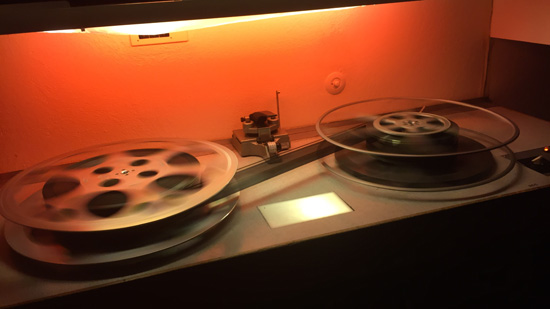 The
70mm print for Rigoletto, Stockholm, Sweden. Image: Matts Kullander The
70mm print for Rigoletto, Stockholm, Sweden. Image: Matts KullanderJAKE MYERS (Executive Producer) previously collaborated with Christopher Nolan as an executive producer on the hit science fiction thriller “Interstellar.” He is currently producing “M:I 6 – Mission Impossible,” the sixth film in the blockbuster franchise, being directed by Christopher McQuarrie and starring Tom Cruise. He previously served as an executive producer on “Mission: Impossible – Rogue Nation” and “Jack Reacher,” both starring Cruise under McQuarrie’s direction. Myers’s prior films as an executive producer include “RED” and its sequel, “RED 2”; “Man on a Ledge”; Allen Coulter’s “Hollywoodland,” starring Ben Affleck and Adrien Brody; and Mikael Håfström’s “1408.” He also produced Håfström’s “Shanghai.” In addition, Myers was a co-producer on Terry Gilliam’s “The Brothers Grimm,” as well as “Brooklyn Babylon” and “Jump Tomorrow.” His credits as a production executive at Miramax Films and Dimension Films include “The Adventures of Sharkboy & Lavagirl 3-D,” “Derailed,” “The Prophecy: Uprising,” “Ella Enchanted” and “Chicago.” HOYTE VAN HOYTEMA (Director of Photography) previously collaborated with director Christopher Nolan on the science fiction action adventure “Interstellar,” for which he received a BAFTA Award nomination and was recognized by a number of critics organizations. Born in Sweden, van Hoytema began his career studying at the esteemed National Film School in Lodz, Poland. He went on to shoot several films, commercials, documentaries and TV series all over Europe, including Poland, Sweden, Norway, Germany and the United Kingdom. In 2008, van Hoytema’s cinematography for Swedish director Tomas Alfredson’s critical masterpiece “Let the Right One In” earned him several international awards and caught the attention of other filmmakers. David O. Russell hired van Hoytema to lens his 2010 film “The Fighter.” The following year, van Hoytema re-teamed with Alfredson on “Tinker Tailor Soldier Spy,” for which he was nominated for both the American Society of Cinematographers (ASC) and BAFTA Awards. Van Hoytema then shot Spike Jonze’s widely acclaimed virtual love story “Her” in 2013. He more recently served as the cinematographer on the 2015 Bond actioner “Spectre,” for director Sam Mendes. |
|
|
Crowley received another ADG Award nomination for his design work on Michael Mann’s “Public Enemies.” His additional film credits include the sci-fi adventure “John Carter”; the romantic drama “The Lake House”; the biopic “Veronica Guerin,” directed by Joel Schumacher; the war drama “Behind Enemy Lines”; and Barry Levinson’s Ireland-set comedy “An Everlasting Piece.” He previously served as an art director on such films as “Mission: Impossible II,” directed by John Woo; Richard Donner’s “Assassins”; Alan J. Pakula’s “The Devil’s Own”; and “Braveheart,” directed by and starring Mel Gibson. In addition to his film work, Crowley recently designed the pilot episode and served as the series concept production designer for HBO’s hit series “Westworld,” created for television by Jonathan Nolan. Earlier this year, Crowley won an ADG Award for his work on the show. |
|
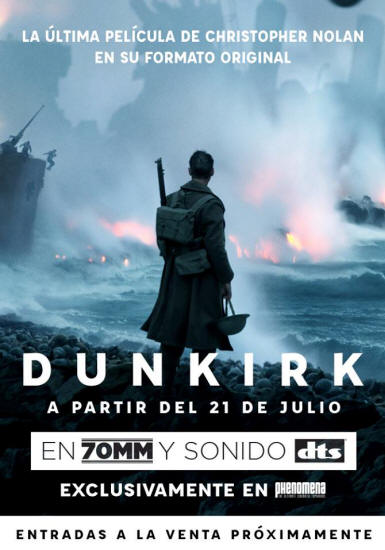 LEE SMITH (Editor) earned Academy Award, BAFTA Award and Eddie Award
nominations for his work on Christopher Nolan’s “The Dark Knight,” and a
BAFTA Award nomination for his work on Nolan’s “Inception.” He has also
collaborated with Nolan on “Interstellar, “The Dark Knight Rises,” “Batman
Begins” and “The Prestige.” LEE SMITH (Editor) earned Academy Award, BAFTA Award and Eddie Award
nominations for his work on Christopher Nolan’s “The Dark Knight,” and a
BAFTA Award nomination for his work on Nolan’s “Inception.” He has also
collaborated with Nolan on “Interstellar, “The Dark Knight Rises,” “Batman
Begins” and “The Prestige.” Smith has also enjoyed a long association with director Peter Weir, earning an Academy Award nomination for his editing work on Weir’s “Master and Commander: The Far Side of the World,” for which he also received an Eddie Award nomination. Smith most recently reunited with Weir for the fact-based drama “The Way Back.” Smith had earlier served as editor and sound designer on Weir’s “The Truman Show,” “Fearless” and “Green Card”; an additional editor on “Dead Poets Society”; and an associate editor and sound designer on “The Year of Living Dangerously,” which began their collaboration. Hailing from Australia, Smith won an Australian Film Institute (AFI) Award for Best Editing on Gregor Jordan’s “Two Hands,” on which he was also the sound designer. As a sound designer, he also won an AFI Award and earned a BAFTA Award nomination for his work on Jane Campion’s “The Piano,” and won an AFI Award for Phillip Noyce’s “Dead Calm.” Smith’s recent credits as an editor also include the Bond film “Spectre,” for director Sam Mendes; Gavin Hood’s “Ender’s Game”; Neill Blomkamp’s “Elysium”; and Matthew Vaughn’s “X-Men: First Class.” He also served as the editor on such films as “Black and White,” “Buffalo Soldiers,” “Risk,” “Joey,” “RoboCop 2,” “Communion” and “Howling III.” JEFFREY KURLAND (Costume Designer) is currently working on Christopher McQuarrie’s actioner “M:I6 – Mission Impossible,” the sixth installment in the blockbuster franchise, starring Tom Cruise. Kurland has devoted much of his career to designing the costumes for Woody Allen films. He received an Academy Award nomination for Best Costume Design for the director’s “Bullets Over Broadway,” and won a BAFTA Award for his work on “Radio Days.” His collaborations with Allen also include “Everyone Says I Love You,” “Mighty Aphrodite,” “Manhattan Murder Mystery,” “Husbands and Wives,” “Shadows and Fog,” “Alice,” “Crimes and Misdemeanors,” “New York Stories,” “Another Woman,” “September,” “Hannah and Her Sisters,” “The Purple Rose of Cairo” and “Broadway Danny Rose.” Kurland previously worked with Christopher Nolan on the 2010 worldwide hit “Inception,” starring Leonardo DiCaprio. His other recent credits include “The Dictator,” starring Sacha Baron Cohen; Richard LaGravenese’s “Beautiful Creatures”; Brad Bird’s “Tomorrowland,” starring George Clooney; and Paul Feig’s reboot of “Ghostbusters,” starring Melissa McCarthy, Kate McKinnon, Kristen Wiig and Leslie Jones. In addition, Kurland served as the costume designer on F. Gary Gray’s crime thriller “Law Abiding Citizen,” starring Jamie Foxx; the adventure “Nim’s Island,” starring Jodie Foster and Abigail Breslin; Andrew Fleming’s mystery adventure “Nancy Drew,” starring Emma Roberts in the title role; Stephen Hopkins’ supernatural thriller “The Reaping”; Michael Mann’s dramatic thriller “Collateral,” starring Tom Cruise and Jamie Foxx; Joe Johnston’s action adventure “Hidalgo”; and the thriller “Criminal,” produced by Steven Soderbergh. He also worked with Soderbergh as the costume designer on the hit films “Ocean’s Eleven,” featuring an all-star cast, and “Erin Brockovich,” starring Julia Roberts, for which he earned a Costume Designers Guild Award. His earlier credits include Milos Forman’s “Man on the Moon,” Neil Jordan’s “In Dreams,” Richard LaGravenese’s “Living Out Loud,” P.J. Hogan’s “My Best Friend’s Wedding,” and the Nora Ephron films “This Is My Life” and “Mixed Nuts.” Kurland has served as governor on the board of the Academy of Motion Picture Arts and Sciences for 12 years, and as the Academy’s first Vice President for the last years. HANS ZIMMER (Composer) has scored more than 120 films, which, combined, have grossed more than 24 billion dollars at the worldwide box office. He has been honored with an Academy Award, two Golden Globes, three Grammys, an American Music Award, and a Tony Award. His most recent Academy Award nomination, for Christopher Nolan’s “Interstellar,” marks his 10th career Oscar nomination. In 2003, ASCAP presented him with the prestigious Henry Mancini Award for Lifetime Achievement for his impressive and influential body of work. He also received his Star on the Hollywood Walk of Fame in 2010 and, in 2014, was honored with the Zurich Film Festival Lifetime Achievement Award. In 2014, Zimmer completed his first concerts in the UK, “Hans Zimmer Revealed,” at the Eventim Apollo in Hammersmith, and concluded his first ever European tour, “Hans Zimmer Live,” in 2016. He recently completed the European leg of his Hans Zimmer Live 2017 tour and is beginning the U.S. portion of the tour, which comes after his wildly successful and well-reviewed performances at Coachella in April. Zimmer’s other recent projects include BBC’s “Planet Earth II”; Ron Howard’s “Genius,” on National Geographic, with Lorne Balfe; the main title music for Netflix’s “The Crown”; the animated “The Boss Baby”; the Oscar-nominated “Hidden Figures,” with Pharrell Williams and Ben Wallfisch; the Ron Howard-directed features “Inferno” and “Rush”; Zack Snyder’s “Batman v Superman: Dawn of Justice” and “Man of Steel”; Mark Osborne’s “The Little Prince”; Peter Sollet’s “Freeheld”; Simon Curtis’s “Woman in Gold”; Marc Webb’s “The Amazing Spider-Man 2”; Steve McQueen’s Oscar-winning “12 Years a Slave”; the History Channel miniseries “The Bible”; the Christopher Nolan-directed films “Inception” and “The Dark Knight” trilogy; and Guy Ritchie’s “Sherlock Holmes” films. Some of Zimmer’s other notable works include his scores for “Rain Man,” “Driving Miss Daisy,” “Thelma & Louise,” “Crimson Tide,” “The Thin Red Line,” “Gladiator,” “Mission: Impossible II,” “Hannibal,” “Pearl Harbor,” “Tears of the Sun,” “Spanglish,” the “Pirates of the Caribbean” franchise, the “Kung Fu Panda” and “Madagascar” animated films, “The Da Vinci Code,” “Frost/Nixon,” and “The Lion King,” for which he won the Academy Award. |
|
| Go: back - top - back issues - news index Updated 21-01-24 |
